
The reason to choose such a long title for the discussion of avant-garde music and its relation to arts in Hungary in the early Eighties is related to the topic. As now, when the musical progression and its relation to the arts of the period became more and more popular in exhibitions and books, we have to ask ourselves how should we limit our overview on the hundreds of bands and its artistic contact in East Europe.
It is also obvious, that the present day use of the term “avant-garde” related to such subcultures like punk or new wave also need an explanation: if its intention is related to avant-garde art we need clear argumentation how or why to connect them. Is it by personal artistic motivation or the new form of expression would be the reason to categorise the art-punk as avant-garde? Or is it related to the connection of two generation, the Seventies neo-avant-garde artists and the newcomers? My proposition will be to be precise in artistic terminology to declare how punk and new wave brought new forms in the years of its appearance, to see how its roots lead us back to former artistic experiments.
As more we know, more and more bands with less and less official recordings comes to the surface to colour the palette of the musical network of the early Eighties over the Iron Curtain, we more and more laminate on the question how to orientate ourselves in such an endless territory. In the forthcoming paragraphs I try to consider three examples of artistic visions, where the inspiration of music and visual art can be described in a clear way. For my examination, I choose my examples from the first part of the decade, as I see that after circa 1986 a slight commercialisation could be experienced in Hungary on the fields of New Wave music – what changed the boundaries of the relation between art and alternative music as well.
To approach the topic, first of all I find necessary to propose a vocabulary what is focusing on the qualities what are overlapping in the two genres, the music and the fine arts. The rise of punk music and new wave caused an overall refreshment by liberating amateurs to play rock music and to use the tunes to express their personal feelings toward the political system, education, society and future. In itself, the amateurism and cross media interest, the number of fine artists playing in bands or musicians making artworks do not prove mutual inspiration unless there is a way to prove it. Our effort is to name keywords what could be understood from the fine art methodology and the music methodology as well. In the following we try to explain such words like: amateurism, avant-garde, constructing/deconstructing, suddenness and irony. This list of words can be extended, but to start a discussion about the topic, I will try to frame the problem with these mentioned words.
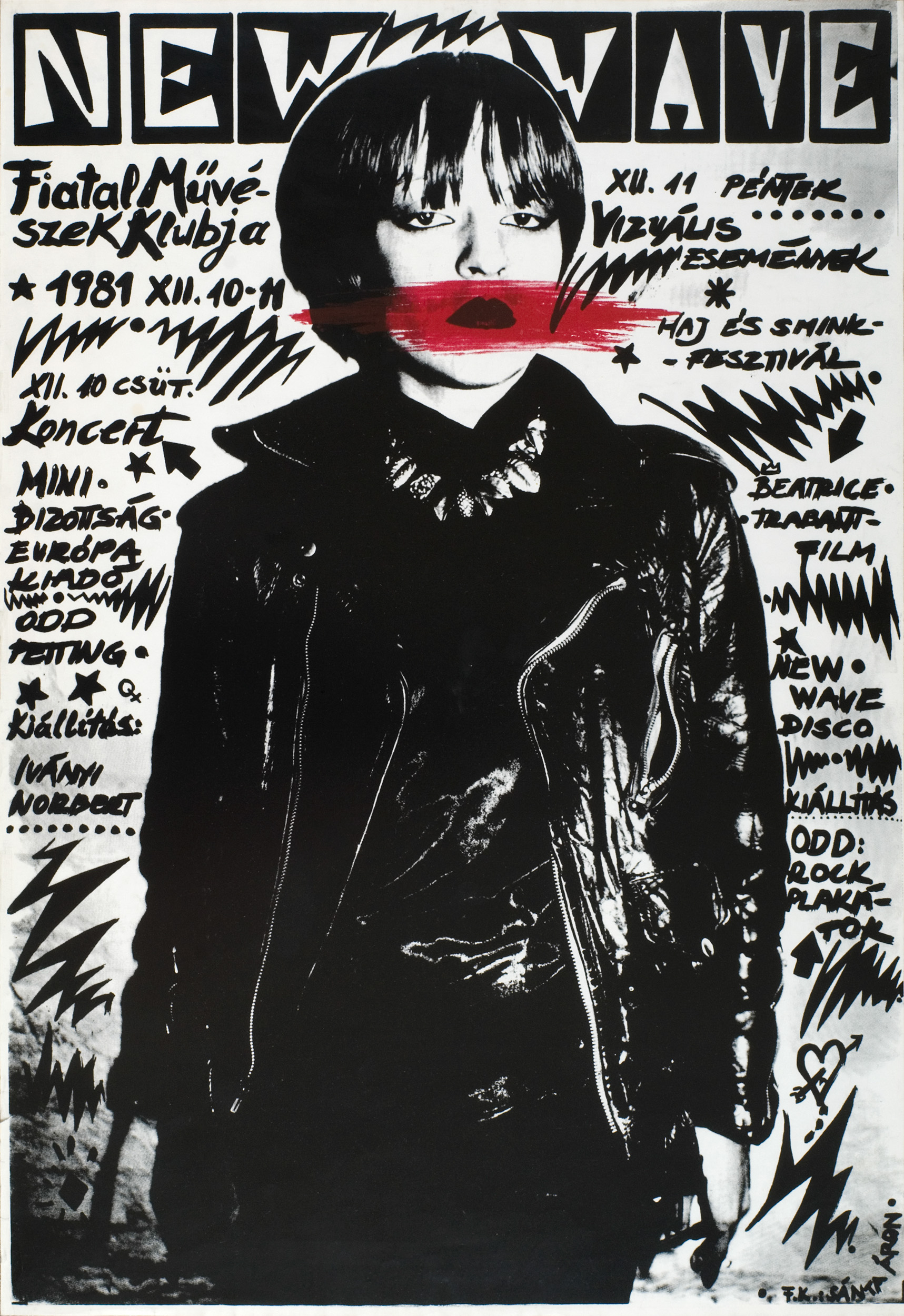
György Soós, New Wave, 10-11.12.1981, poster for ‘New Wave’ concert in Young Artists Club (FMK), photo: Tamás Diner, design: György Soós, Norbert Iványi, model: Thomai Ioannidou, offset printing, 48,3 x 70,3 cm. Source of reproductions: Infernal Golden Age. Hungarian New Wave posters of the ’80s from the collections of György Bp. Szabó and Tamás Szőnyei (published: 2017, Kieselbach, edited by Gábor Rieder). Digitization at the Artpool Art Research Center, Budapest
Before getting in the explanations, we have to underline some facts from the history of popular music, or how it was understood in Hungary. When we speak with active participants of the period, it seems so that their roots lead us back to the Seventies. The base of the change of the musical perception already started in the early years of the decade, with the vison of such classic musicians as Jimi Hendrix and David Bowie. Regarding the forerunners of the changes, Kraftwerk’s early activities can be mentioned what proved that musicians can be engineers, who actively interfere in sound making, inventing electronic tools to perform their imaginations. Their new musical instruments as objects became calling for fine artists in Hungary to produce their own tools in the early Eighties. Another example would be The Residents music in the early Seventies by the freedom of editing sound, and gave an example of anonymity in progressive music, even in their performances. The new classical music also found new ways after John Cage: the works of the repetitive school like Steve Reich became popular in artistic circles in Hungary. The industrial, noise base approach of the Throbbing Gristle became known as a new form of musical avant-gardism appearing after John Cage’s use of environmental sounds and electronic equipment. The punk, as an expression of freedom in music and in lyrics had an overall influence in the Eastern Block as political and main stream musical criticism, which faced the audience with slogans of commercialism and political contradictions. Like a new form of literary and musical expression, the musicians, text writers, singers quickly find their way to university clubs, Culture Houses where they could perform for their small and intellectual audience. The “punk” type of performers got fast recognition and fashionable attention as subversive figures in Budapest and other big cities of the country, following the style of stars like Johnny Rotten, Joey Ramone, Wattie Buchan, Siouxsie Sioux, Debbie Harry, Robert Smith and Morrissey.
The vocabulary of the cross influences: Amateur / Dilettante, Avant-garde, Suddenness, Irony, Constructing / Deconstructing.
To construct a vocabulary seems important to understand the influences and qualities appearing both in music and on the fine artist field. The intention of this survey is also to open a channel to the research of international contacts and networks. To see precisely what were the inspiring directions abroad and what was easy to understand and to follow in local conditions. To approach this, I try to name some of the possible characters what – in the Hungarian political and economic environment – could get a local reading and meaning.
Amateur / Dilettante
In Eastern Europe, the official art associations divided their organizational sections to two parts: on one side there was the “authorised” artists with diplomas as full members of the organizations, but on the other hand to give place to educative creativity, many had “amateur” sections for artists who did or could not attain higher art education. In some cases, the “amateur” platforms became more vivid and creative in certain years by being liberated from artistic traditions. As such, the amateur groups could give a positive inspiration for the professionals as well[1]. The word “amateur” also on the pop music field, in this context had a positive meaning, a free will of expression, where professional skills were less important than creativity. “Amateurism” in music and in fine arts had an understandable meaning: something interesting, what is outside of any official valuations and standards. An “amateur” looking work or sounding song could be playful but deep in meaning, childish in the usage of lines or instruments, but an expression of the time. In music, “amateur” could be punkish, where no guitar solos were needed, but strong emotional and textual expression and energy could be felt in between the lines – causing in many cases the surveillance of the authorities at concerts, and of the band members.
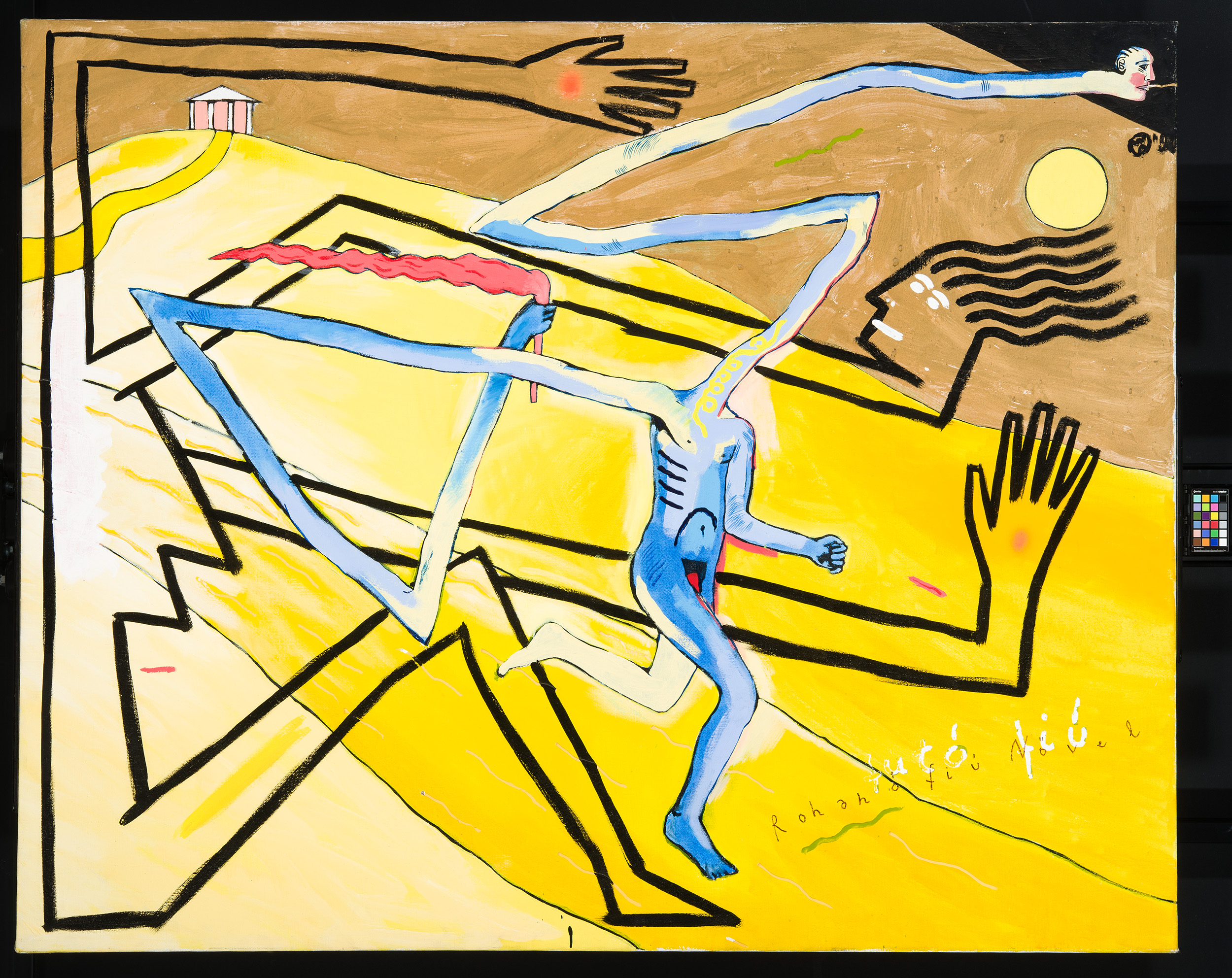
András Wahorn, ‘Running Boy with a Woman’, 1990, oil on canvas, 160 × 200 cm, The Contemporary Collection of the Hungarian National Gallery, nr inw.: MM91.111
Just to compare, the word “dilettante” – as it was used in Germany – Geniale Dilletanten[2] – had a different connotation. The “dilettante” in Hungary, compared with “amateur”, had a negative meaning, used to somebody, who is not intelligent in her/his artistic work, not skilled and misunderstanding the artistic context. The “amateur” in music and in arts as well was turning clumsiness and naivety into an aesthetic character. The interest toward the “amateur” artist laid in their character and motivated behaviour to produce new aspects of arts and music. In time, many of them elaborated professional skills, but in basis, in the first part of the 1980s, there was an openness in the artistic audience to see and to hear something unusual, what came frequently from the non-educated side.
Avant-garde
In many cases the word “avant-garde” is what labels new wave musicians in the texts speaking about the Eastern Block music scene. The real meaning of this category from the artist’s side is to accept and to follow the avant-garde tradition of the 20th century, to refer to the formal and content-based experiments[3], and propose provocative, new language in art and music as well. This means that we slightly have to differ the “avant-garde” as a qualifier from punk and new wave music tendencies in general. The originality of music experimentation and its connection with arts was related in Hungary as well to Andy Warhol and his contact with the Velvet Underground and the Rolling Stones. The record cover this circle proved the overlapping of art and graphic design connected with music[*4]. The next pop star who influenced the artists was surely David Bowie, whose interest in fashion and design showed a new type of artist. Brian Eno and Roxy Music also have shown a direction how pop and composing can reach the same platform.
The avant-garde underlined the artistic intentions on the contrary of pop music references, or it have defined that the product is on the edge of experimentation. Comparing “avant-garde” with “underground”, the second referred more to the “non-official”, the “Forbidden” or “Tolerated” in Hungarian cultural policy[5]. The underground in itself collected different musical and artistic styles, less connected with the avant-garde tradition[6]. The third word, the “alternative[7]” was used to the genre from the second part of the Eighties, to propose a new way in music culture, a way what is a parallel development, with its own value and distribution system.
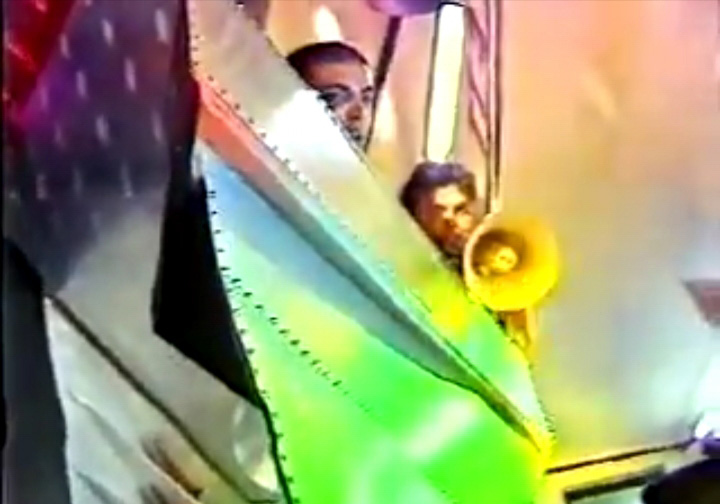
Gábor Bachman, 1986, ‘Work Action’, pub video, screenplay and direction: Bachman Gábor, architecture and design plan of the Work Action Pub: Bachman Gábor, camera: Kardos Sándor, costumes: Király Tamás, sound: Art Deco, Soós György, actors: members of the Art Deco group, courtesy of the artist
Suddenness
The “avant-garde” in the early Eighties in the music and fine art scene also referred to the possibility of suddenness, what was an important phenomena in the Hungarian artistic circles of the time. Miklós Erdély, Dóra Maurer as artists, and László Beke as a theorist underlined randomness as a methodology and starting position of artistic creation. The unexpected as modifier of the artwork lead to new solutions and experiments. Miklós Erdély led a pedagogical group from 1978 until 1986 called INDIGO where many performance artists like András Böröcz, János Szirtes or János Sugár attained, and in many cases connected music with their performative activities. The unexpected element related the scene to the rich Hungarian free jazz tradition as well. “Suddenness” as an improvisational element became important for such bands like the Art Deco or the Galloping Coroners. The artist A.R. Penck, was also known in Hungary, who played his improvisations solo and in his groups T.T.T., but his painted figures also expressed the automatism of drawing, painting and composing on a canvas.
Irony
“Irony” as another performative and stage element came from many examples, inspirations of the time. “Irony” had a political connotation, as any kind of verbal reference lead to observation. Anyhow, in Hungarian poetry, literature and filmmaking the humour and the symbolism of verbal jokes played an important role in the early Eighties to reduce tension in the society. The lyrics of music also brought this irony also as expressing “joie de vivre” to overcome the problems and struggles of everyday life. The Irony played an important role in some bands vision, like the A.E Biztottság, the Balkán Futurist, Vaszlavik Gazember László and others. The international references of this aspect comes partly from the The Residents with their masks and videos and more the German Der Plan who played an important role in understanding irony as part of the avant-garde practices. Their playful stage designs, posters, costumes, record covers by Moritz Reichel (Moritz D.) and Frank Fenstermacher had a strong impact in Hungary.
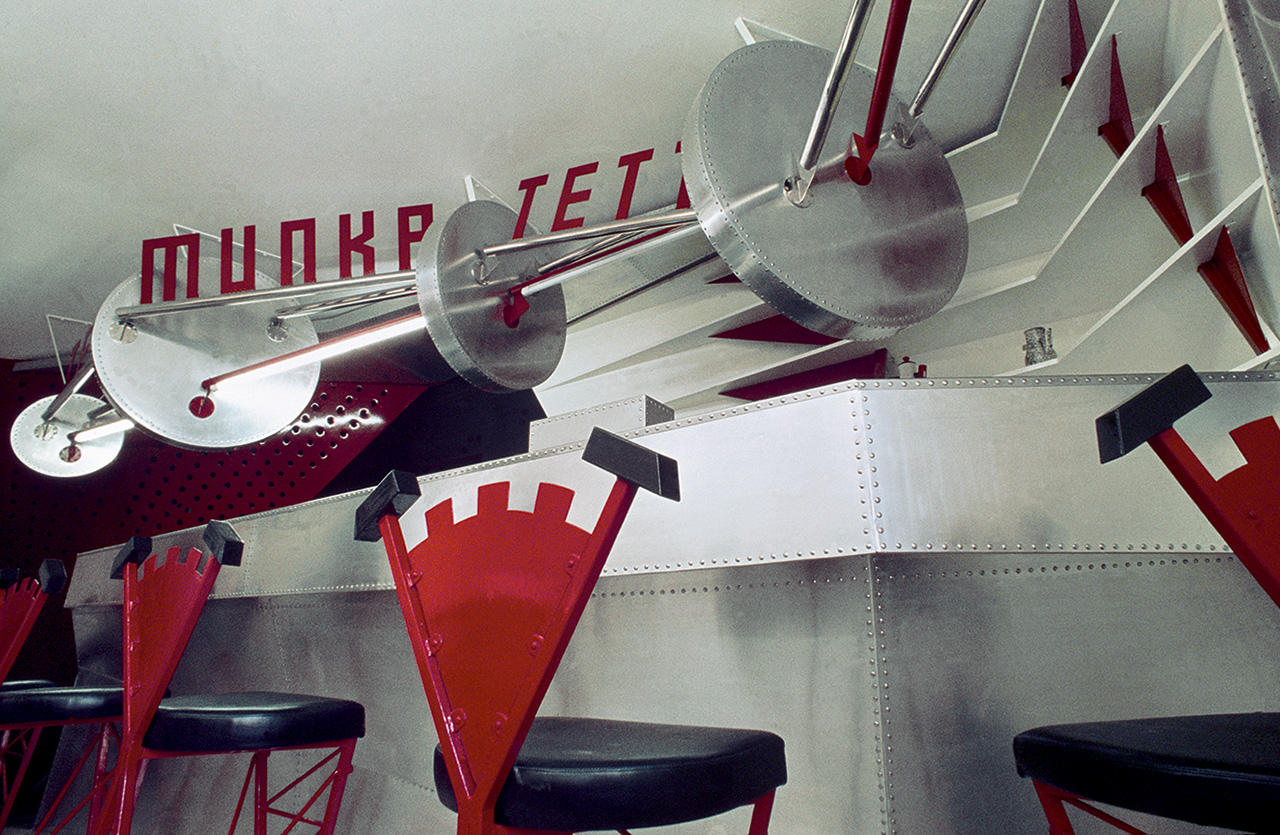
Gábor Bachman, ‘Work Action Pub’ (Szigetszentmiklós), 1986 (destroyed in 1988), photo: Bachman Gábor, courtesy of the artist
Construction / Deconstruction
Construction / deconstruction are two other ideas that acquired importance at the end of the Seventies and the beginning of the Eighties – connecting the imagination about music with art practices. They are not just about formal references on early Russian avant-garde, but important concepts toward the content itself. To “deconstruct” also meant to ignore official and general-taste value systems, to proceed toward new aesthetics, new qualities. Construction / deconstruction had a strong connotation with contemporary music. The presentations of the new authors like John Cage, Witold Lutoslawski and György Ligeti in the Seventies at the concerts of the “New Music Studio”[8] underlined the consequent lineage of musical experiments from Béla Bartók through Igor Stravinsky up to John Cage. The “deconstruction” of the classical structures, scores visual appearance gave the neo-avant-garde idea of new logic in contemporary music, open to electronic instruments, noises, and unexpected happenings. The beginning of Eighties bought another dimension on the contemporary music field in Hungary, the recognition of the repetitive music, a new aspect of audible constructivism. The New Music Studio and the Group 180[9] had created an audience overlapping with the audience and authors of the New Wave and avant-garde. With such a background the musical experiments on the underground side could be well established with locally approachable examples and performances.
The actual information about new, experimental popular and contemporary music was an important question of the time to be able to follow trends, tendencies and to formulate an opinion about what is relevant locally and what is not. The cassettes sent by cousins and friends living on the West with excellent music selections immediately put such bands like the DAF, Einsturzende Neubauten, Crass, Der Plan etc. to the centre of the interest of artistic circles. The magazine NME was subscribed to by individuals and some libraries as well. The visual design of the magazine immediately shown that there is a “global visual revolution”[10] what could be seen not just on the layout of the magazine, but also on the stage visuals and dressing of the bands and singers. The styles gathered in the category of punk and New Wave was not defined precisely, but it liberated the music making and the artistic expressions as well. Another source for visual inspiration could be the record covers and in many cases inserted fanzines, what gave a strong feedback to local graphic designers that what they do is an outstanding, up-to-date quality, what is practically the same looking as it appeared on the Western underground scene.
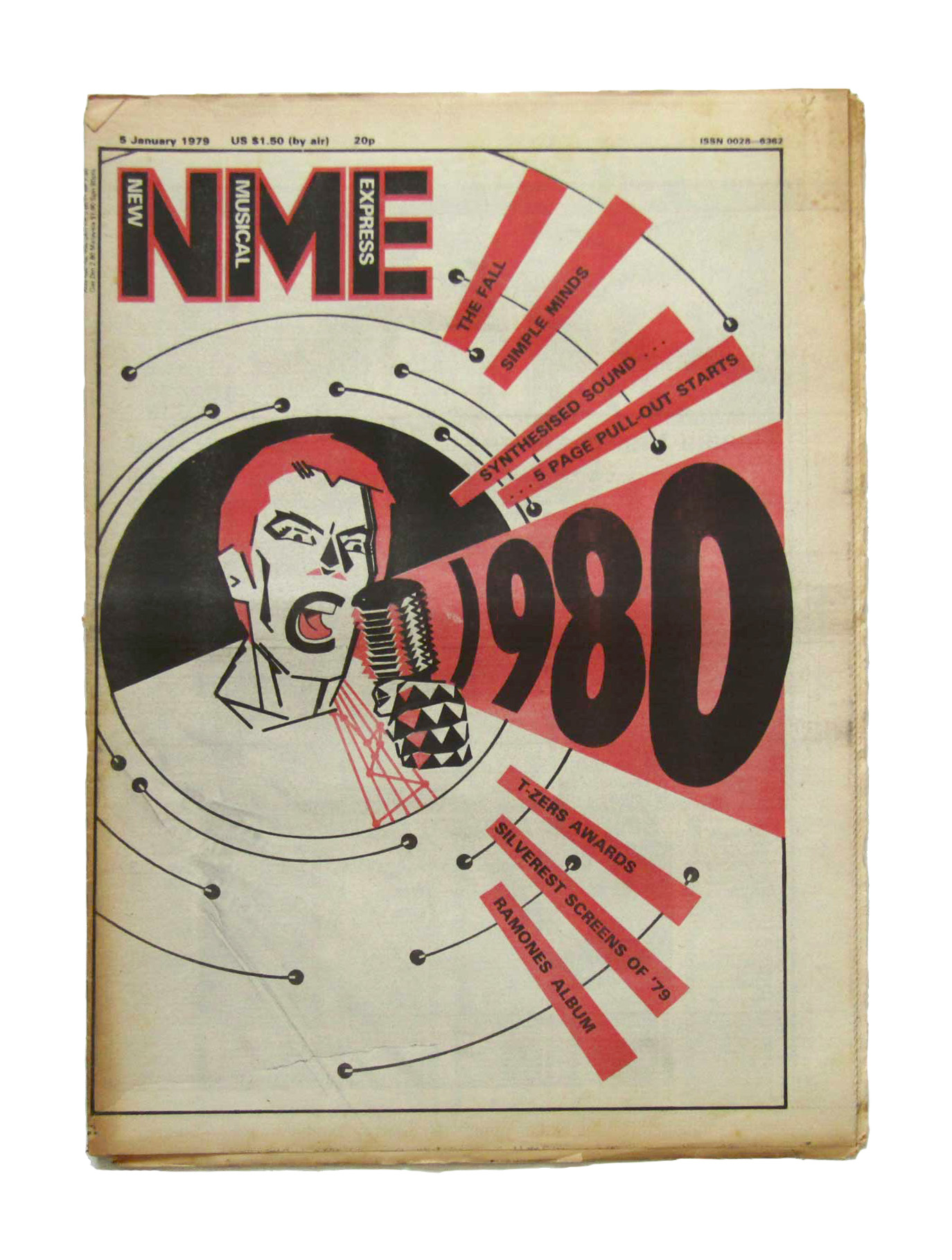
‘New Musical Express’, cover, 5 January 1979
Art Deco, György Soós, Gábor Bachman and the idea of deconstruction
As suggested, I would like to put in a centre three circles of musicians and artists, whose ideas and methods brought together the avant-garde music and the fine arts. The first will be the industrial music formation the Art Deco[11] with its leading figure, György Soós, whose musical, graphic and performative activities introduced the industrial music in Hungary[12]. His ideas met with the ideas of Gábor Bachman, architect, designer: in their parallel activities the interior design, graphic design, furniture making, film scenery planning, industrial music, projection, poster design defined the idea of deconstruction and industrial aesthetics. Their joint work led to such designed events like the concert of Einstürzende Neubauten in Budapest in 1986, or two videos by Gábor Bachman using the band and its music by the Art Deco titled “Constructed Landscapes” and “Work-Action” in 1985 and 1986.
In the only book about his work subtitled: “Ars Nova, the Iconography of Post-Industrial Age”, György Soós and the authors[13] of the book refers to industrial music as a global style with many references leading back to the early avant-garde, to the Futurists, and the Russian Avant-garde artists who declared the validity of the new aesthetics of a new epoch, namely the victory of the machines, the speed and the urban development. The neo-avant-garde tendencies, the performance as a new experiment of the totality of arts, a cross-genre gave birth to new ways to imagine a musical concert. Projection, S/M tools, suits, man and woman dresses recalling totalitarian systems gave the environment to musicians playing on industrial materials and musical instruments. This idea was elaborated in Britain by the mentioned Throbbing Gristle, and followed by the Test Department and the Einstürzende Neubauten in Berlin. In the Eastern Block, Yugoslav Laibach, Borhese with the Hungarian Art Deco gave a different meaning to the workers or military uniform. Here the unpopular social realism and its ideology of human labour was criticised by pointing by the dresses to futuristic visions of future, power and work in its purest sense.
Gábor Bachman as an architect, interior designer and film-architect made several films with Gábor Bódy at the beginning of the Eighties. Particularly in the movie called the “Night-Chant of the Dog” he experimented with punk / New Wave light effects, defining with colours, shadows, filters, a sensational vision what could express the “zeitgeist”. In this movie, two bands of the time, the “A.E. Bizottság”, an art-rock group (please see below), and the avant-garde-folk band, the “Galloping Coroners” appeared in the movie making the experimental film unexpectedly popular. Bachman – developing his own artistic language in the end of the Seventies, came close to the industrial vision and the deconstruction of structures. He extended his vision in such TV Films like “Bela Bartók: Duke Bluebeard’s Castle” directed by Miklós Szinetár in 1981 and “Hamlet” directed by Gábor Bódy also in 1981. His keynote video, the mentioned “Constructed Landscapes” was recalling the Russian avant-garde trains[14] in a factory landscape with the music and performative appearance of the Art Deco. In this short movie, beside the music, the visuals, and the dresses designed by Tamás Király[15] another genre also appears by text of Péter Esterházy, the writer who made many propositions how to deconstruct the Hungarian language and its meanings.
The period of the Eighties is a complex époque: the pop musical revolution had its effect on the fine arts and vice versa, but the high arts fatigue on the avant-garde also gave place to new expressions on multiple levels: we have to see that the new “heftige malerei”[16] influencing Hungarian artists from Berlin had many punk contacts around Martin Kippenberger, Albert Oehlen, Jiří Georg Dokoupil, etc., but the newly used idea, “Postmodernism” also declared, that the time passed over the modernist, strict, philosophical trends. The brutality, the gestures and the thickness of the paint expressed new times, the selfish choices of motives turned art from logic back to emotions. The direct links between the two genres, the fine arts and the pop-culture, the high and low was in most of the cases personal, as in the west, here in Eastern Europe as well. The other artistic circle I wish to mention in my paper proves the importance of personal connections and the chain of effects of how the New Wave style elements arrived in Hungary.

Zuzu-Vető (Lóránt Zuzu Méhes – János Vető), ‘The Soldiers of the art in stadium’, 1983, acrylic on canvas, 80 x 109,5 cm, private collection, courtesy of the artist
János Vető with Lóránt Zuzu Méhes, and the New Wave aesthetics
The connection between avant-garde art and music leads us back till the end of the sixties and a key person, who influenced the experimental attitude of the next decade. János Baksa-Soós, the front singer of the KEX group[17] was known of his unique performances and improvisations on stage. Being frequently harassed by the authorities, after one and a half year of activity he emigrated to West-Germany[18] with his sister, Vera Baksa-Sóos in 1971. After different locations they ended up in Düsseldorf, where János Baksa-Soós joined the Art Academy under the guidance of Joseph Beuys, Georg Richter and Rolf Sackenheim[19], while Vera studied history. She was integrated in the local art and punk scene on the end of the Seventies, singing and performing in such bands like the Der Plan and the Minus Delta T[20]. The idea of art punk in Düsseldorf was more intellectual than in other parts of Germany and Europe: her personal contacts helped the Hungarian scene to get access to the bands and their artistic vision. The mentioned Gábor Bódy, film director married Vera Baksa-Soós in 1980, when she returned to Budapest[21]. Vera Baksa-Soós’s close friend, János Vető, photographer, musician, artists became influenced by these trends, and, himself, invited bands like Der Plan, Die Unbekanten, die Toten Hosen and Laibach to play in Budapest. Vető also worked together with Tibor Hajas performance artists in the second part of the Seventies, for whom he documented all of his actions. Hajas, who died tragically in 1980, was as poet and performer a forerunner of the artistic activities of the next decade. By describing this personal contacts, the art and alternative music scene of the Eighties gets a different context, a complex network of references in Hungary.
János Vető’s photographic activities led him to joint work with a painter Lóránt Zuzu Méhes who made hyperrealistic works at the end of the Seventies and started to make sunglasses of paper and coloured plastic film as a side project. Friends as fashion models wearing these accessories were photographed by Vető, and sometimes coloured and painted by Méhes. From 1981, they painted and performed together on the name “Zuzu-Vető”. Their action-painted canvases expressed the need of a new visuality which is not following the “Neue Wilde” paintings, but was more connected with the openness to the new urban music and lifestyle. The sunglasses and the painted works continue to suggest a kind of positivity, a “joie de vivre” the looseness of the socialist system. They expressed naivety, playfulness, humour and suddenness by working together in a nearly automatic way: the drawings like figures on the surface followed each other until they filled the composition or the surface. The inspiration of these works came partly from Moritz Reichelt (Moritz R) member of Der Plan, but the result is an authentic, outstanding work what gives a special character to the early Eighties art manifestations. Zuzu-Vető’s works also recall the drawing method of A.R. Penck, whose vision as artist show close parallels with his musical “side” as an avant-garde improviser.
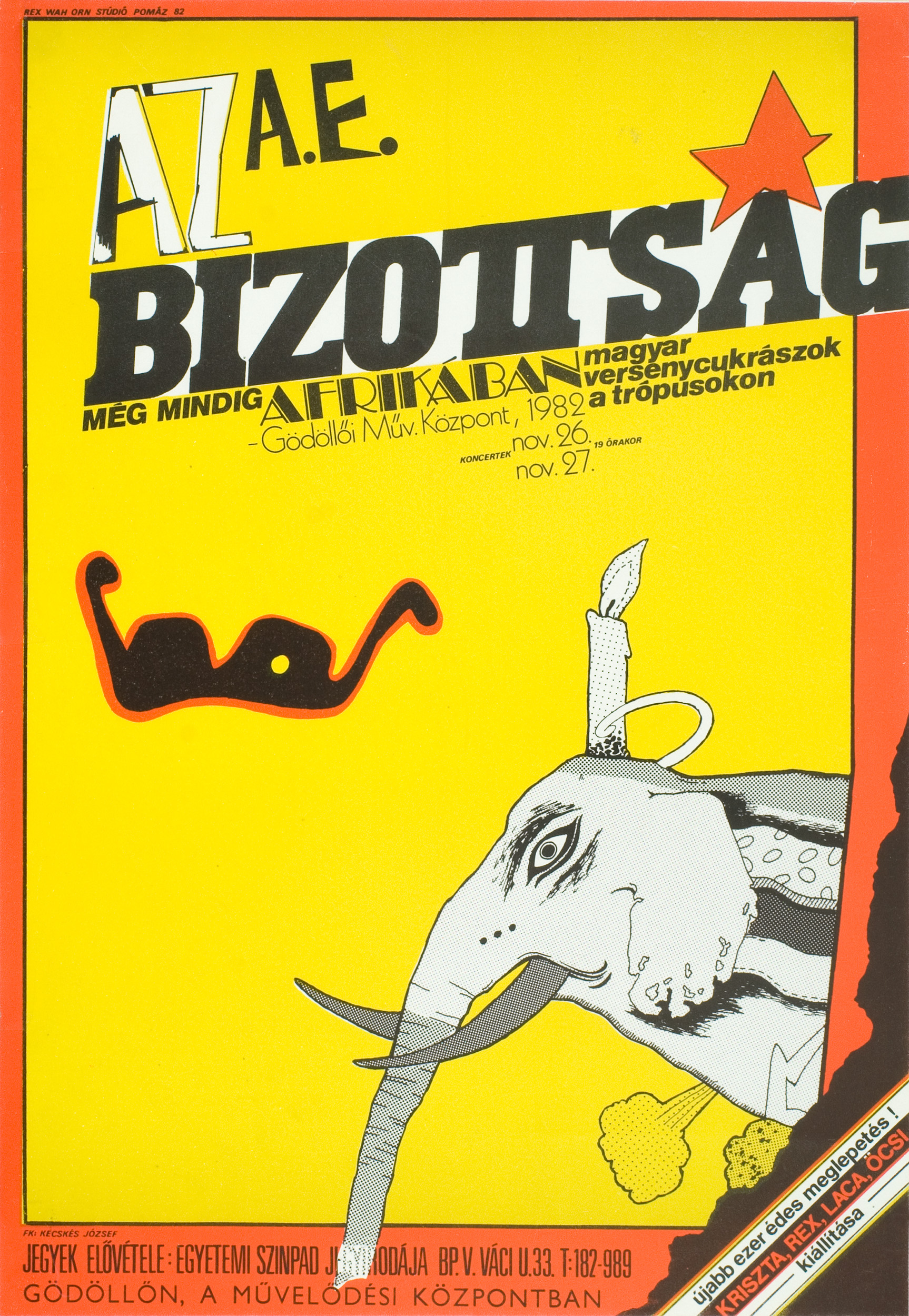
András Wahorn, poster for the concert ‘Committee A. E. still in Africa. Hungarian Confectioners in the tropics’, Culture Centre in Gödöllő, 26-27 November 1982. Source of reproductions: Infernal Golden Age. Hungarian New Wave posters of the ’80s from the collections of György Bp. Szabó and Tamás Szőnyei (published: 2017, Kieselbach, edited by Gábor Rieder). Digitization at the Artpool Art Research Center, Budapest
The A.E. Bizottság
Regarding the topic of connecting art and music in the “New Wave” era, certainly in Hungary the most successful example would be the A.E.Bizottság (Committee A.E.)[22] and the activity of its artist members, András Wahorn, fe László Lugossy, István ef Zámbó and Sándor Bernáth(y)[23]. Their activity started in Szentendre and Pomáz close to Budapest[24]. Their artistic inspiration rooted in Dadaism and Surrealism, what connected their music with avant-garde poetry. As they explain in their interviews about the history of the band[25], the un-understand ability of their lyrics was one of the key of their early success, as the audience could “project” any kind of meaning to their sentences. The paintings and graphic works they produced during this period was more about irony and the combinations of everyday objects as primary motives. As amateur artists they gathered in a young artists’ studio called the Lajos Vajda Studio in Szentendre; their artworks inspired each other, showing stylistic similarities. The surrealistic combination of motives lead to special appearance of the work, what brought coherency to what they did with how they played their music. Somehow their music passed official controls and the managerial motivation of András Wahorn led to the realization of two LP-s as well[26]. Their concerts included performative elements, where unexpected motives played an important role. The concert posters of the A.E. Bizottság concerts were mostly designed by András Wahorn. With their artistic vision on public walls, their style got wider attendance and recognition. In their work, the “amateurism”, “avant-garde” references, “suddenness” – unexpected behaviour, “irony” appears as characteristics. But regarding the internationality of their art, A.E. Bizottság was an isolated concept. Their charisma attracted their own audience, and their complex activities defined in Hungary for a wider public the phenomena of the arty side of New Wave[27].
The time of the Eighties, the art-music connections and inspirations in Eastern European countries cannot be discussed in isolation from the Western networks of the artists. The bands, artists, performers, sometimes just through their legend, or records, concerts, inspired the Hungarians, gave inspiration or energy to follow their own imagination. At a time when the secret police still was active and reported about the punk movement, made these artist “subversive” or “oppositional” as a category. The political system, turning to its last decade, confronted with new western trends holding up dangerous slogans. “No Future”, “Fuck the system”, and other sentences appearing on T-skirts somehow forecasted the declination of an age and a political behaviour. This generation who followed the new trends in arts and music, became forerunners of the fall of the Wall and the fall of socialism.

The text first appeared in the book ART BREAKS FREE. Art in the PRL, CSRS and WRL in the 1980s. published by the Culture and Art Center in Wrocław.
[1] A case would be the section of amateur photographers in the end of the ’70s in the Association of Photographers in Hungary. The group experimented with avant-garde methods and approaches – out of this circle there emerged the highly respected “Dokumentum” exhibition series organized by Antal Jokesz and János Szerencsés from 1978 in Veszprém, Hungary.
[2] Geniale Dilletanten was the title of a music festivalin September 4, 1981, Tempodrom, Berlin, and in 1982 the title of the book of Wolfgang Müller, Merve Verlag, Berlin. See more of its German context in: Geniale Dilletanten – Brilliant Dilletantes, Subculture in Germany in the 1980s, edited by: Leonhard Emmerling, Mathilde Weh, Goethe Institute, Hatje Kantz Verlag, Ostfildern, 2015
[3] In the book of Emese Kürti: Glissando and String Plucking, Contemporary Music and Neo-avant-garde art in Underground Personal Spaces, 1958-1970, the author describes the importance of international contemporary music in the elaboration of performance as genre – which seems to be a link to the performative practices of the avant-garde and New Wave bands in Hungary.
[4] Andy Warhol’s record covers: The Velvet underground & Nico: The Velvet Underground & Nico, West Coast Pressing, 1967, The Rolling Stones: Sticky Fingers, Rolling Stones Records, 1971 were the most prominent ones
[5] The “Supported, Tolerated, Forbidden” categories was connected to György Aczél, cultural politician, mostly in power during the Sixties and Seventies.
[6] See: Notes from the Underground, Art and Alternative Music in East Europe 1968-1994, Ed.: David Crowley, Daniel Muzyczuk, Muzeum Sztuki, Lódz, Koenig Books, London, Lódz, 2016
[7] The word in Hungary in connection with underground music was first used by György Soós as a title of a festival: “Alternative ’84 – Shaman Musix”, held at the Ráday Club in 1984.
[8] The New Music Studio was established in 1970(-1990) with the goal to help to know new post-war music trends in Hungary of composers such as John Cage, Karlheinz Stockhausen and Pierre Boulez. Its members were composers, like László sáry, Zoltán Jeney, Péter Eötvös and others, who also themselves played at concerts, mixing their own pieces with international ones.
[9] Formulated in 1979(-1990) the goal of the orchestra was to acquaint new repetitive tendencies of music by Steve Reich and Philip Glass. This group also had composer members like Tibor Szemző, István Márta, László Melis and Béla Faragó.
[10] This expression was used by János Vető in the interview I made with him to this article. He was in close contact with Chris Bohn, a writer for the New Musical Express, who wrote an article about the Hungarian underground scene in 1980 for the NME, and illustrated the text with the photos of János Vető – after their collaboration, János received the NME magazines for years by post.
[11] The Art Deco was appearing in posters as A.D.O., three letters what could be read differently as well. As György Soós said to me in a recent interview one of the possible readings was “Avant-garde Design Orchestra” connecting them with the avant-garde tradition.
[12] The industrial music as a possible inspiration appears on the side of the “New Music Studio” in a special work by Zoltán Jeney composed for an exhibition opening by György Buczkó, glass artist: For Glass and Metal, for tape,1979, published in 1982, on an LP of the Author: Zoltán Jeney: To Apollo, For Glass and Metal, Soliloquium No. 3, Hungaroton, 1982. The recordings were done at the Steel Factory of Dunaújváros and a glass-engraving studio. Jeney states on the record cover that he wanted to use the original noises of special labour processes; what he calls ‘so rich electronic modifying’ was not necessary.
[13] Authors like Droid Us Jaeger, Miklós Peternák, András Bojár Iván and Tivadar Godwin Krausz. The book was published by the Műcsarnok / Kunsthalle Budapest, 2001
[14] The “Agitpoyezd” trains designed by cutting-edge artists travelled through the new empire to educate masses in different topics in the Soviet Union. From 1918 until 1922, 19 trains were constructed for this purpose, decorated or designed by the best artists of the time.
[15] The most relevant, the only internationally recognized Hungarian fashion designer, creating also New Wave street fashion in Hungary in the ’80s in his boutique called “New Wave Boutique”.
[16] The artists inspired by the Heftige malerei or Neue Wilde in Hungary was a loose group curated by Lóránt Hegyi. The style was called “Új szenzibilitás” (New Sensibility).
[17] Rock band active from 1969 till 1971, known for their poetic, surrealistic texts.
[18] János Vető and György Soós both described the period after the emigration of János Baksa-Soós as a kind of emptiness in the alternative music scene in Hungary in the interviews the author of this article made with them.
[19] János Baksa-Soós got his master degree in Düsseldorf Art Academy in 1978.
[20] The details of the contact with the Düsseldorf Punk scene and her participation is described in the interview by Kata Balázs and Ágnes Szabó-Eszter, in: Artmagazin, 2019.8., p.12.
[21] On their wedding prominent members of the Düsseldorf art and music scene appeared in Budapest, like the members of the Der Plan. This information had been told by Frank Fenstermacher band member.
[22] A.E. referred to Albert Einstein
[23] The non-artist members were: Erzsébet “Kokó” Kukta, István “Joni” Szulovszky and Mária Bán
[24] See the short description of the story of A.E,Bizottság in: „Notes from the Underground, Art and Alternative Music in Eastern Europe, 1968-1994” edited by David Crowley, Daniel Muzyczuk, Muzeum Sztuki, Łódź, Koenig Books, London, Łódź, 2016, p. 202
[25] In a program called „Private Rock History” two parts is dedicated to the history of Bizottság(only on Hungarian) https://www.youtube.com/watch?v=uGG18xmwC2Y&t=2468s, https://www.youtube.com/watch?v=HDIZ4ip34NU, downloaded 2020, 02.23.
[26] Kalandra Fel!(To Adventure!)1983, Jégkrémbalett(Ice Cream Balet)1984
[27] Their western European tour was their last series of concerts before their dissolution in 1985
